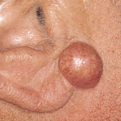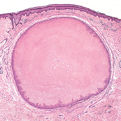Sebaceous Cyst
General Information
Sebaceous cyst also known as epidermal cyst, is the result of an implantation of epidermal elements in the dermis. Several factors can lead to this implantation including damage to a hair follicle, a ruptured sebaceous gland, developmental defect or heredity. The cyst contains a “pasty” substance called keratin (material that makes up hair and the outer layer of the skin), which may have a foul odor if drained. Sebaceous cyst can occur any where on the body, but are mainly seen on the face, trunk and neck. The cysts are harmless and unless they are on a location that is causing discomfort, pain or if an infection occurs, they can be left alone. If the cysts are causing discomfort, pain or an infection occurs a healthcare provider may recommend corticosteroid injections, incision and drainage, total excision, minimal excision or laser treatment. To prevent scarring and infection patients are advised not to try to drain the cysts themselves, this should be done by a professional only.
Epidemiology
Extremely common, male to female ratio 2:1
Etiology
Abnormal proliferation of cells
Pathogenesis
PCells on surface move deep into the skin and multiply
Clinical
Firm, round, mobile, flesh-colored to yellow or white subcutaneous nodules of variable size
Histology
Stratified squamous epithelium that contains a granular layer and is filled with keratinous material that is often in a laminated arrangement.
Bibliography
1. “Epidermoid cysts (sebaceous cysts)” June 2007 (Online). http://www.mayoclinic.com/health/sebaceous-cysts/DS00979/DSECTION=1 (visited: April 3, 2008) 2. “Epidermal Inclusion Cyst” (Online). May 2006. http://www.emedicine.com/derm/TOPIC860.HTM (visited: April 3, 2008)
Download PDF
![]() Sebaceous Cyst
Sebaceous Cyst


